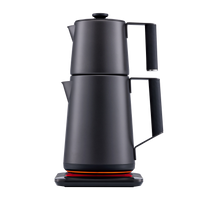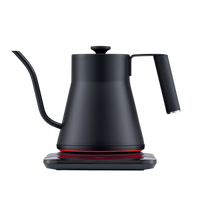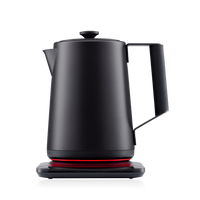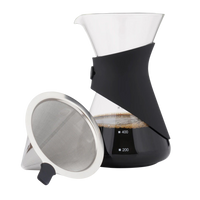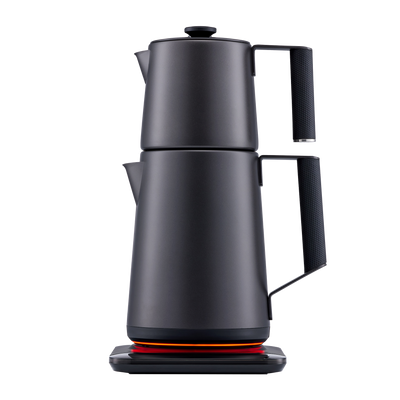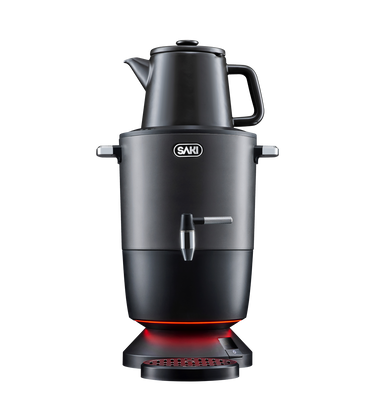how to make turkish tea: easy turkish tea recipe in 8 steps

Summary: Learn how to brew a perfect cup of authentic Turkish tea with this 8-step guide! We'll help you select the best tea leaves, explain the significance of a Turkish double teapot tea making method, and show you how to serve this delightful beverage like a local.
At the heart of Turkey lies its treasured beverage, "çay" (pronounced "chai"). More than just a drink, it signifies hospitality, culture, and the age-old tradition of meaningful conversations. Those vibrant tulip-shaped glasses, brimming with a deep amber potion, often spark curiosity. Today, we unravel the secrets of this iconic beverage and guide you in replicating the authentic experience at home.
What is Turkish Tea?
Turkish tea, known as çay, is a traditional hot beverage consumed at any time of the day in Turkish homes in Turkey. Tea in Turkey is much more than just being a hot beverage, being a significant part of Turkish culture and hospitality.
Turkish tea can be made with any black tea in the market but there is also Turkish black tea leaves originating from the Black Sea region of Turkey where climate is ideal for tea plantation.
Turkish tea differs from other black teas such as English tea in its brewing method. It is brewed in a double teapot for longer time. Turkish black tea is served in small, tulip-shaped glasses to encourage slow sipping. It appeals not only to the taste but also to the eye with its reddish-amber color.
Traditional Turkish Tea Making Methods
Turkish tea traditions feature a diverse array of brewing tools, all using the double teapot method to provide a unique flavor and tea experience.
Turkish people typically make tea with a Turkish teapot set, called "çaydanlık". These sets consist of two teapots of different sizes stacked on top of each other; the smaller one on top is for steeping tea, while the larger one at the bottom is for boiling water. The çaydanlık does not have its own heat source and is used on a stove.
Nowadays, there are also electric Turkish tea makers. These tea makers function like traditional çaydanlıks but are equipped with built-in electric heating elements, eliminating the need for an external heat source like a stove.
Some tea lovers also use Russian samovars to make tea. In some exotic Turkish restaurants, it is especially common to bring out a traditional samovar for guests to enjoy tea after the meal. Samovars can serve large quantities of tea at once, which is important for busy Turkish social events.
A traditional samovar is designed for heating water through a central coal or charcoal-burning compartment. It is commonly used to brew tea in a teapot placed on top, using a method similar to that of the Turkish tea makers.
Similarly, an electric samovar is designed to function like its traditional counterpart but eliminates the need for coal or charcoal by incorporating a built-in electric heating element as its heat source.
Different brewing equipment shows how flexible Turkish tea culture can be. Each method adds its own distinct taste to the tea, from simple double tea kettle to electric tea maker machines.
Essentials for Brewing Turkish Tea
To enjoy an authentic cup of Turkish tea, you need the right equipment and high-quality ingredients. The "çaydanlık", a traditional two-tiered Turkish teapot, is crucial. In this setup, the bottom tier boils the water while the top, filled with tea leaves, brews a concentrated infusion.
For those who might not have access to a çaydanlık, the TeaSmart Turkish Double Tea Kettle provides a modern, electric alternative that maintains the tradition.
Ingredients: Quality is Key
- Turkish black tea leaves, preferably from the Black Sea region, celebrated for their robust flavor.
- Filtered or bottled water, as the water quality is paramount to the tea's final taste.
- For every 100 ml of water, use about 1 full teaspoon (4 gram) of tea. Adjust this ratio based on your taste preferences.
- Optional: Enhance your tea with additives like Earl Grey, clove, or a cinnamon stick. Sugar cubes and lemon slices are also popular additions.
Equipment: Meet the "Çaydanlık"
- A çaydanlık (a double tea kettle) or an Electric Double Tea Maker for brewing.
- Turkish tea glasses (bardak), small, tulip-shaped glasses that are perfect for savoring tea slowly.
Step-by-step Guide to Brewing Authentic Turkish Black Tea
Step 1: Begin with quality water
Fill the bottom kettle with fresh, cold, filtered water. Use enough water to fill the tea glasses you plan to serve. The quality of water is the foundation of your tea’s flavor profile.
Step 2: Continue with quality tea
Choose good quality, loose black tea. Rize tea from the Black Sea region of Turkey is the most traditional one and gives a tea flavor unique to the region. However, you can make Turkish tea with any high-quality black tea. So, choose one from you local store.
Step 3: Adjust the right amount as it matters
Turkish tea is typically strong, so don't shy away from generous measurements. For every tea glass you intend to serve, use one full teaspoon of tea leaves. Put it in the upper kettle, and place the kettle on top of the one with water.
Step 4: Master the double boiling method
Turkish tea is brewed in a double tea kettle, known as "çaydanlık" in Turkish. It is a two-tiered tea kettle. The smaller upper part is for steeping tea and the larger bottom pot is boiling water. This setup provides a continous heat to tea infusion on top, letting all flavors of tea leaves infuse into water. The result is a perfect balance of strength and aroma.
Bring the water in the bottom pot into a boil, and once its boils, pour the boiling water over the tea leaves in the upper pot, being aware of the amount according to tea-water ratio of your preference. Add water to the bottom pot if needed, which will then be boiled again, and place the upper pot on top of it.
Pro Tip: For an effortless authentic tea-making experience, we recommend using a Electric Dobule Tea Maker like SAKI's TeaSmart. It replicates the traditional brewing process and provides the same tea experience at your convenience.
Step 5: Let it steep
Patience brews perfection. So, steep the leaves for 10 to 15 minutes to let them release their full flavor and aroma into water. Some tea leaves may take 20 minutes to get the complete flavor. The Turkish tea brewing method using a double tea kettle provides continuous heat from the bottom pot, so you do not have to worry about the tea getting cold during steeping.
Step 6: Prepare your Turkish tea glasses or porcelain teacups
While your tea is brewing, prepare your glasses or teacups. Turkish tea is usually drunk in tulip-shaped thin glasses, but it may also be served in traditional porcelain teacups.
Step 7: Serve it right
Pour the tea from the upper pot into the glass, filling only about one-third to half of it. Then, dilute the strong brew with the hot water from the bottom kettle to your desired strength. The perfect color should be a rich, dark amber or deep red color, depending on the tea leaves, being reminiscent of a sunset.
Step 8: Sip slowly to enjoy
People traditionally enjoy Turkish tea without milk. Some people prefer a sugar cube or two, and some might like a slice of lemon. With or without these additions, you should drink Turkish tea slowly in small sips, being aware of it hotter than a tea made in a single teapot.

The Turkish Electric Tea Maker simplifies these steps into an effortless ritual, ensuring a flawless Turkish tea experience.
Conclusion
Remember, a cup of Turkish tea is more than a beverage - it's an experience steeped in culture and tradition. It fosters conversations and strengthens bonds.
Keep in mind, the perfect cup of Turkish çay depends on the tea's quality, the double brewing method and patience for a perfect steeping. There are many delightful tea sessions waiting for you. Let them be a time to connect, a tradition to share, and a pause to enjoy simplicity and being together.
Ready to experience the authentic flavor of Turkish tea at home? Explore the convenience of brewing traditional Turkish tea with the TeaSmart Electric Turkish Tea Maker.
Common Questions & Answers
Q: Can I also use samovar to make Turkish tea?
A: Yes, you can use samovar to make Turkish tea because it is a dual teapot as well. Explore modern electric samovars in this link.
Q: Should I use loose tea leaves or tea bags?
A: Choosing loose tea leaves is always better are for a richer taste. Tea bags, with their added material, might slightly alter the brew's flavor.
Q: What type of teapot is best for Turkish tea?
A: Porcelain teapots are the most recommended teapots to make Turkish tea. However, the essence lies in the tea leaves' quality and water. For porcelain teapot options, click this link.
Q: How much tea and water should I use to make Turkish black tea?
A: A general rule is to use one full teaspoon (4 grams) of tea leaves and 100 ml of boiling water per glass to be served, but please feel free to adjust this ratio based on your taste preferences and the black tea you use.
Q: How long should I brew Turkish black tea?
A: Patience is the most critical ingredient in brewing Turkish tea. Allow your tea to brew for at least 15 minutes, though many connoisseurs recommend a full half-hour. This slow infusion is crucial for a full-bodied flavor.
Q: What is the best way to serve Turkish tea?
A: After the tea has steeped, fill the glasses one-third to half with tea, then top up with hot water. Achieving the perfect dark amber hue is an art in itself — a balance between strength and subtlety.
